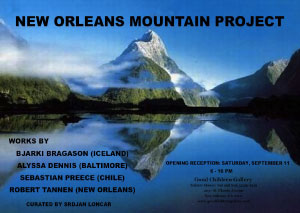September 11 - October 3
Sailing to Byzantium: curated by Adrian Price
Featuring work by:
Jessica Bizer, Brian Guidry, Rachel Jones, Philippe
Landry, Sophie Lvoff, Jeremy Pelt, Adrian Price and
Minka Stoyanova

|
|
New Orleans Mountain Project:
curated by Srdjan Loncar
Featuring work by:
Bjarki Bragason (Iceland), Alyssa Dennis (Baltimore), Sebastian Preece (Chile) and Robert Tannen (New Orleans)
 |
View images of show
here
Sailing to Byzantium
Statement by Thomasine Bartlett
In 1926 William Butler Yeats wrote the poem Sailing to Byzantium. The
poem, first published in 1928, is Yeats statement on the agony of old age and
the difficulty of maintaining spiritual vitality when the spirit is tied to a failing
body. The poem explores the merger of immortality, art and the human spirit.
The “failing body” of Yeats can be compared to the recent “failings” of society –
particularly in New Orleans. September 11, the scheduled Saturday for the Good
Children opening, is the anniversary of the attack on the twin towers in New York.
The date is also less than two weeks after the fifth anniversary of Hurricane
Katrina and falls in the wake of the recent oil spill in the Gulf. The agony of
these events in a vital, living city, fighting to re-assert itself, is similar to the pain
and anguish of an aging, failing body housing a still-active spirit.
Yeats is known for privileging the artificial over the natural – and this poem is
no exception. The journey is an imaginary one – he never actually traveled
to Byzantium, which was itself mythical in 1926. Byzantium, founded by the
Greeks sometime in the 7th century BC and subject to constant turmoil, became
Constantinople in the 4th Century, and in 1930 was re-named Istanbul. Starting
his poem with, “That is no country for old men,” Yeats relays the anguish of
becoming “a paltry thing, a tattered coat upon a stick” – unless the spirit “sings.”
Yeats begs to be gathered into the “artifice of eternity,” to become an artificial
thing such as “Grecian goldsmiths make of hammered gold,” finding his own
immortality as Art.
As New Orleans struggles to rise up like a mythical phoenix from its former
ashes, determined to maintain its unique beauty despite an on going battering,
Yeats’ imaginary journey to a mythical place to establish spiritual immortality
speaks directly to us. Curator Adrian Price understands the necessity of
spiritually transcending catastrophe to establish spiritual rebirth, but also
understands the difficulty of undertaking such a journey. Imaginary flights – often
depicted as real Art – offer insights and alternatives, ways of using artifice as
the real, or juxtaposed to the real, to offer – at least – fresh insight. The eight
artists, including herself, who Price invited to participate with her in this show, are
Jessica Bizer, Brian Guidry, Rachel Jones, Phillipe Landry, Sophie lvoff, Jeremy
Pelt and Minka Stoyanova. All are artists who utilize the imaginary as an integral
part of their work. Some favor the juxtapositions, some the fancy and flight, while
others are intrigued by the artificial. All, however, seek to find truth – or somepart
of the truth -- through their work. The upcoming Good Children show should
prove to be an interesting addition to the growing list of innovative SCAD-NOLA
efforts making headlines in the New Orleans art scene.



